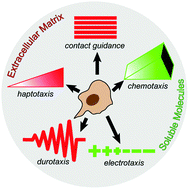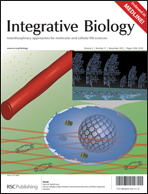Directed cell migration in multi-cue environments
Abstract
Cell migration plays a critical role in development, angiogenesis, immune response, wound healing and cancer metastasis. During these processes, cells are often directed to migrate towards targets by sensing aligned fibers or gradients in concentration, mechanical properties or electric field. Often times, cells must integrate migrational information from several of these different cues. While the cell migration behavior, signal transduction and cytoskeleton dynamics elicited by individual directional cues has been largely determined, responses to multiple directional cues are much less understood. However, initial work has pointed to several interesting behaviors in multi-cue environments, including competition and cooperation between cues to determine the migrational responses of cells. Much of the work on multi-cue sensing has been driven by the recent development of approaches to systematically and simultaneously control directional cues in vitro coupled with analysis and modeling that quantitatively describe those responses. In this review we present an overview of multi-cue directed migration with an emphasis on how cues compete or cooperate. We outline how multi-cue responses such as cue dominance might change depending on other environmental inputs. Finally, the challenges associated with the design of the environments to control multiple cues and the analysis and modeling of cell migration in multi-cue environments as well as some interesting biological questions associated with migration in complex environments are discussed. Understanding multi-cue migrational responses is critical to the mechanistic description of physiology and pathology, but also to the design of engineered tissues, where cell migration must be orchestrated to form specific tissue structures.


 Please wait while we load your content...
Please wait while we load your content...